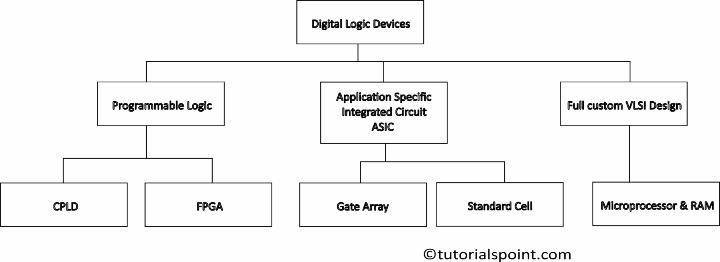
 Data Structure
Data Structure Networking
Networking RDBMS
RDBMS Operating System
Operating System Java
Java MS Excel
MS Excel iOS
iOS HTML
HTML CSS
CSS Android
Android Python
Python C Programming
C Programming C++
C++ C#
C# MongoDB
MongoDB MySQL
MySQL Javascript
Javascript PHP
PHP
- Selected Reading
- UPSC IAS Exams Notes
- Developer's Best Practices
- Questions and Answers
- Effective Resume Writing
- HR Interview Questions
- Computer Glossary
- Who is Who
Implementation of Digital System
An Overview
Our modern world is now completely dependent on digital technology, which also drive innovation and change entire industries. Advanced functionality, effective processing, and seamless connectivity are made possible by digital systems, which are used in everything from computers to cellphones to communication networks to control systems. This article will examine the design and execution of digital systems, illuminating the crucial processes necessary to fully utilize digital technology.
Digital System
Systems that process and transmit data using binary representation are referred to as digital systems since they run on digital signals. These systems rely on discrete values of 0s and 1s to represent and manipulate data, and they are founded on the concepts of digital electronics.
Computers, telecommunications, consumer electronics, and control systems all employ digital systems extensively. They are made with the aid of digital logic gates, such as AND, OR, and NOT gates, which process binary inputs to produce binary outputs.
Digital systems' essential components include
Logic Gates Basic building elements called logic gates carry out logical operations on binary inputs to produce binary outputs. To create more sophisticated circuits, they are combined.
Flip-flops Flip-flops are storage components used in digital systems to store and synchronise binary information. They serve as the foundation for memory components such as registers and counters.
Multiplexers and Demultiplexers Using multiplexers and demultiplexers, you can choose one of several inputs and direct it to a single output, while demultiplexers do the opposite.
Arithmetic Logic Units (ALUs) ALUs are arithmetic and logical devices that carry out operations including addition, subtraction, AND, OR, and XOR. They are frequently utilised for computing in processors.
Registers Registers are storage components of a digital system that store binary data. They are employed for synchronisation, buffering, and short-term storage.
Memory To store and retrieve data, digital systems use a variety of memory types. This comprises flash memory and various types of non-volatile memory such as random-access memory (RAM) and read-only memory (ROM).
Digital-to-analog converters (DACs) and analog-to-digital converters (ADCs) These converters, known as digital-to-analog converters (DACs) and analog-to-digital converters (ADCs), serve as the interface between the digital and analogue worlds and enable the processing and interaction of analogue signals by digital systems.
Engineers can define the behaviour and structure of the system by utilising hardware description languages (HDLs), such as Verilog or VHDL, while designing digital systems. In order to construct complicated digital designs, they are also utilised in conjunction with field-programmable gate arrays (FPGAs) or application-specific integrated circuits (ASICs).
The development of potent computers, fast communication networks, digital media devices, and complex control systems has been made possible by the improvements in digital systems, which have transformed numerous sectors.
Implementation
The design and construction of a system that processes digital signals using electronic parts and circuits is the implementation of a digital system. The following steps are often included in the process

Device Technologies used for Implementing Digital Systems
Requirements Analysis Identification of the system needs is the first stage in putting a digital system into place. This entails defining the system's inputs and outputs as well as the necessary functionality, performance indicators, and other system-level specifications.
System Design After the requirements are established, the system design phase entails high-level design of the digital system. This includes deciding on the architectures and parts that will be used to construct the system. Block diagrams are also created during the system design phase, as are the many functional building blocks that will be used in the system.
Circuit Design The specific circuits that will be used to implement the functional blocks found in the system design phase are designed during the circuit design phase. In order to do this, electronic components like flip-flops, registers, and logic gates must be chosen, and circuit designs must be created to provide the necessary functionality.
Simulation Following the completion of the circuit designs, simulations are run to check the circuits' functionality. In order to validate the functionality and performance of the digital system, simulation utilising specialised software tools is required.
Printed Circuit Board (PCB) Layout Circuit simulation and verification are followed by the printed circuit board (PCB) layout step. In order to create the digital system, the printed circuit board's physical layout must be designed. The PCB layout phase, which establishes the physical form factor of the system, is a crucial stage in the implementation process.
Making a prototype After the PCB layout is complete, a prototype of the digital system is made. This include putting the PCB together, adding the electronic parts, and running the system through functional tests to make sure everything works as it should.
Testing and Verification After the prototype is put together, it goes through a battery of tests to make sure it satisfies all the system requirements. To assure the system's reliability and robustness, this also entails testing it in various environments.
Production The digital system can be used in production once it has undergone thorough verification. This entails mass producing the system and making sure the production procedure is reliable and reproducible.
Conclusion
Innovative technologies can be realised through the challenging yet rewarding procedures of designing and implementing digital systems. Engineers can create digital systems by carefully examining the requirements, designing circuits, simulating and confirming functioning, and iterating through prototyping and testing. We can achieve effective processing, seamless communication, accurate control, and improved connectivity thanks to these technologies. For engineers influencing the direction of technology, mastering the art of digital system design is becoming more and more important as the digital revolution proceeds.

